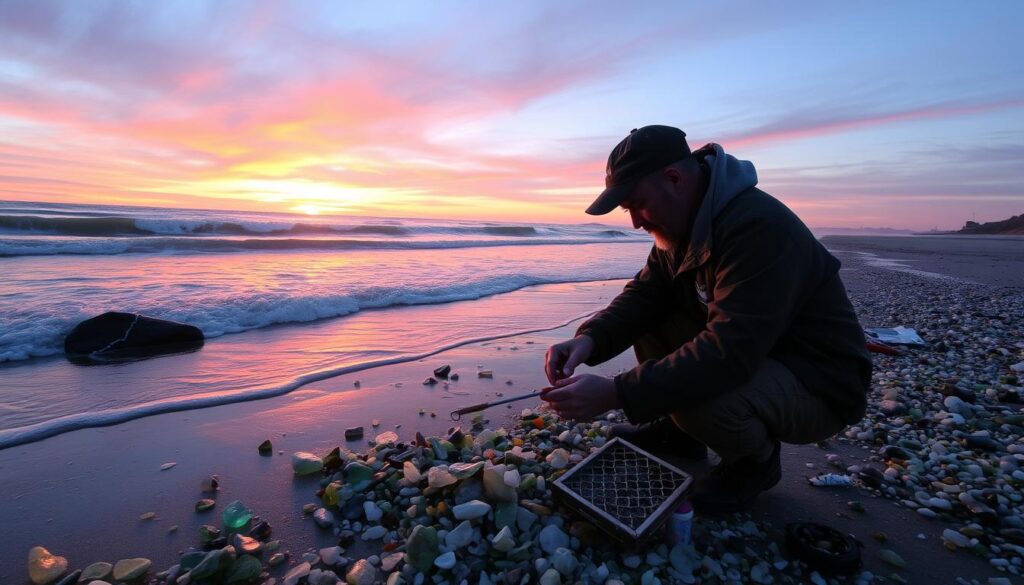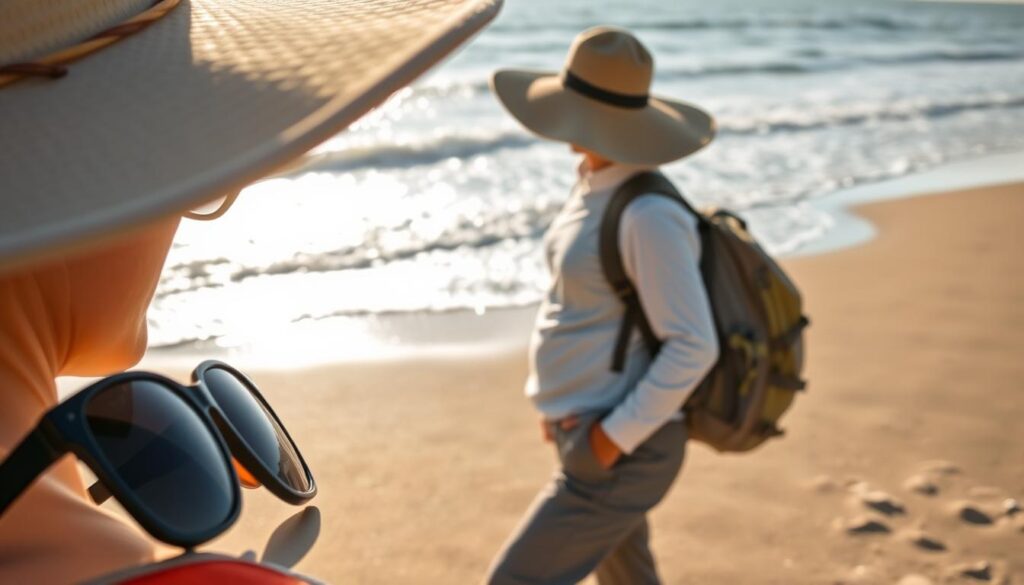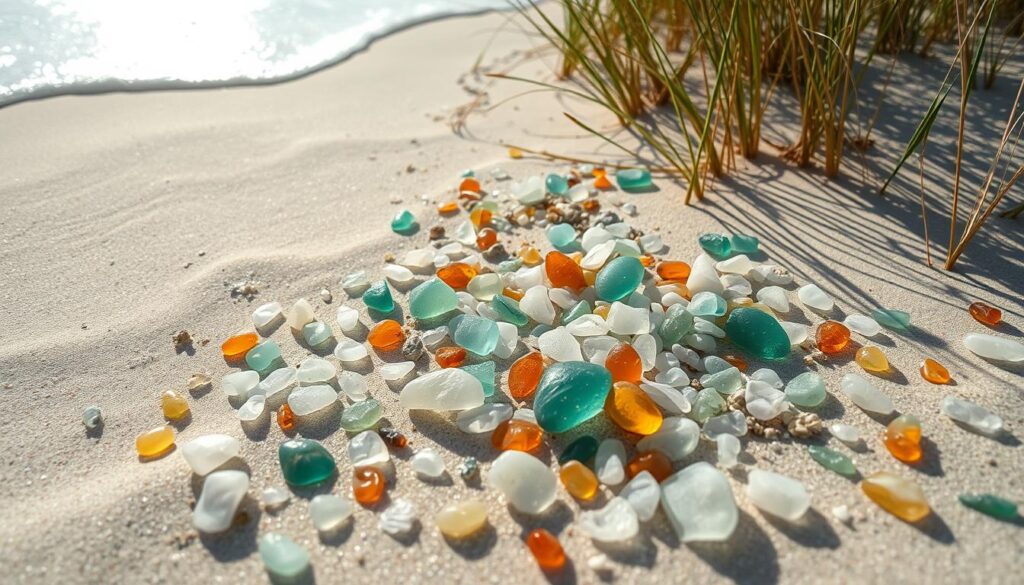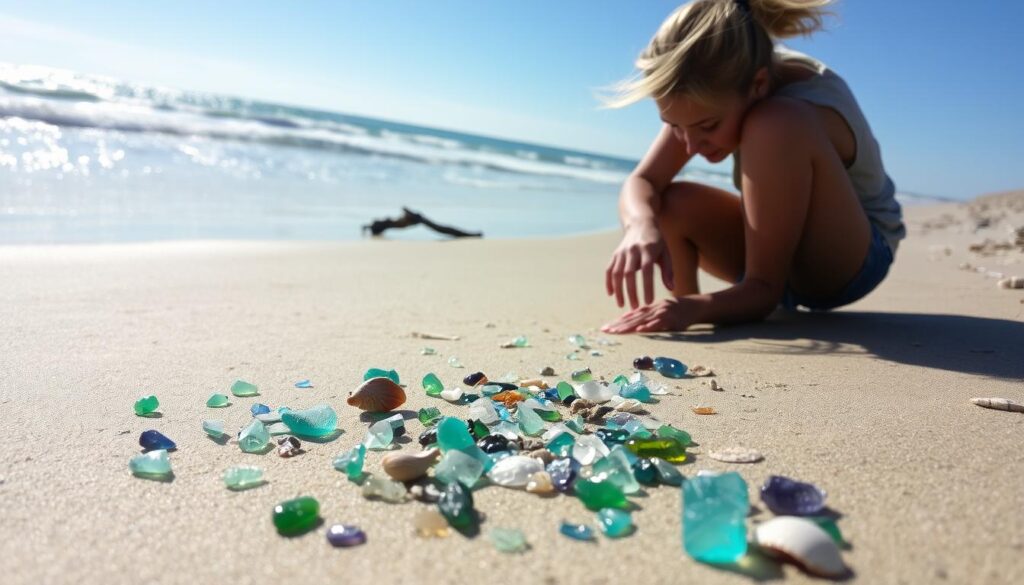Embarking on a sea glass hunt can be a thrilling adventure, combining the excitement of treasure hunting with the serenity of being by the water. As you prepare for your journey, understanding the essentials is key to a successful and enjoyable experience.
Knowing what to expect and being properly equipped can make all the difference. Sea glass, weathered glass fragments tumbled by water and sand, can be found on various beaches, with urban beaches near former dump sites or shipping routes often yielding the best results.
To make your hunt both productive and enjoyable, consider the tides, weather, and beach access. With the right gear and knowledge, you’ll be well on your way to discovering unique treasures transformed by the ocean.
The Essentials of Sea Glass Hunting
To enjoy sea glass hunting, you need to grasp the essentials of how sea glass is formed and where to find it. Sea glass is created when discarded glass items, such as bottles and jars, are weathered and tumbled by the ocean’s waves, sand, and rocks over many years, transforming their sharp edges into smooth, frosted treasures.
Understanding Sea Glass and Its Appeal
Sea glass forms through a natural process that can take 10-20 years or more, depending on the conditions. The appeal of sea glass lies in its transformation from human waste into something beautiful and valuable, with rare colors like cobalt blue, purple, and red being particularly prized by collectors. The quality of sea glass is determined by its color, clarity, and the smoothness of its surface.
Planning Your Sea Glass Adventure
Planning a successful sea glass adventure requires research about potential hunting locations, understanding beach access points, and learning about the history of the area to identify likely spots for quality finds. The best beaches for sea glass hunting are typically those with a history of human activity, such as urban beaches, old garbage dumps, or beaches along historic shipping routes. Timing is also crucial, as factors like seasons, recent storms, and tourist activity can significantly impact the availability of glass on beaches.
What to Bring on a Sea Glass Hunt: Essential Gear & Safety Tips
To maximize your sea glass hunting experience, you’ll need to pack the right tools and take necessary safety precautions.
Basic Equipment Checklist
The basic equipment for sea glass hunting includes protective gear such as sunscreen, a hat, and sunglasses to shield you from the sun. You’ll also need collection containers, preferably mesh bags that allow sand and water to drain, keeping your sea glass finds secure.
Safety essentials include a fully charged phone with emergency contacts, a portable charger, and basic first aid supplies. A waterproof waist pack or small backpack is also crucial for keeping your valuables secure while you search the beaches.
Optional Tools for Serious Hunters
For serious sea glass hunters, specialized tools can enhance your hunting experience. These include hand rakes, sand sifters, and telescoping scoops that help uncover sea glass hidden beneath layers of sand, pebbles, or shells.
Other useful supplies include a small towel for drying off, a camera for documenting special finds, and a notebook for recording information about successful hunting locations and conditions.

Collection Bags and Storage Solutions
When heading out on a sea glass hunt, having the right collection bags and storage solutions is crucial for a successful and enjoyable experience. The right gear helps you keep your treasures safe and organized.
Mesh Bags: The Sea Glass Hunter’s Best Friend
Mesh bags are considered the best collection containers for sea glass hunting. They allow sand and water to drain while keeping your treasures secure. When selecting a mesh bag, look for durable materials with a fine weave that prevents small pieces of sea glass from falling through.
The ideal mesh bag should be comfortable to wear, with features like wrist straps or cross-body designs. This ensures that you can move freely while beachcombing without worrying about your bag.
Organizing Your Finds
Once you’ve collected your sea glass, organizing your finds is essential. Consider using clear containers at home to display your sea glass collection by color, size, or quality. This not only protects the pieces from damage but also allows you to appreciate your collection.
Some beachcombers use different containers for various categories of finds – one for premium sea glass, another for common pieces, and separate containers for shells or other beach treasures. Avoid using plastic bags on the beach as they trap moisture, sand, and debris with your sea glass, potentially damaging delicate pieces.
Proper Footwear for Different Beach Terrains
Choosing the appropriate footwear is crucial for an enjoyable and safe sea glass hunting experience. The type of footwear needed can vary significantly depending on the beach terrain, weather conditions, and how far into the water you plan to venture.
Water Shoes vs. Hiking Boots vs. Wellies
For beaches in summer, water shoes or aqua socks provide good protection while allowing water to drain quickly and preventing hot sand from burning your feet. On the other hand, rocky beaches require sturdier footwear like hiking boots or trail shoes with good ankle support to prevent injuries when climbing over slippery or unstable rocks.
Protecting Your Feet on Rocky Beaches
When hunting for sea glass on rocky beaches, it’s essential to wear footwear that provides protection and stability. Hiking boots are ideal for navigating rough terrain, while Wellington boots (wellies) are perfect for wading into shallow water in colder weather. Additionally, consider the back support your footwear provides, as sea glass hunting often involves hours of bending and stooping.
In winter conditions, insulated waterproof boots with good traction are essential for safety on icy or snow-covered beaches. By choosing the right footwear, you can ensure a safe and enjoyable sea glass hunting experience.
Sun and Weather Protection
As you embark on your sea glass adventure, safeguarding against sun and weather conditions is essential. The beach environment, with its reflective water and sand, can intensify the effects of the sun and weather, making protection a top priority.
Sunblock, Hats, and Sunglasses
Sun protection is crucial for sea glass hunters, regardless of the season. The sun’s damage occurs year-round, and it’s vital to wear sunblock daily, even on cloudy days or when it’s cold outside. Apply a quality sunblock with broad-spectrum protection (UVA and UVB) that has an SPF of 30 or higher. Additionally, a wide-brimmed hat and polarized sunglasses with 100% UV protection can protect your face and eyes while reducing glare on the water.

Preparing for Changing Weather Conditions
Weather at the beach can change rapidly, so it’s wise to be prepared. Packing layers allows you to adjust to temperature fluctuations throughout the day. Consider bringing a compact poncho or rain jacket, as well as waterproof storage for your electronic devices. In the summer, opt for lightweight, quick-drying fabrics with UPF protection for the best combination of sun protection and comfort.
By being prepared for both sun and changing weather conditions, you can enjoy your sea glass hunting experience without unnecessary interruptions or discomfort.
Safety Essentials for Beachcombing
As you prepare for your sea glass hunting excursion, understanding the safety essentials is vital. Beachcombing can be a fun and rewarding hobby, but it comes with its own set of risks, particularly related to the ocean’s power and changing conditions.
Communication and Emergency Preparedness
Always let someone know when you’re heading to the beach and bring your cell phone with you. It’s a good idea to carry your phone in a waterproof case to protect it from water damage. This way, you’ll be able to call for help in case of an emergency. Make sure your phone is fully charged before you leave.
Understanding Tides and Currents
Researching the tides for the beach you’re visiting is crucial. Try to plan your visit a bit after high tide so you can walk the beach as the tide recedes. Understanding tide charts is not only important for finding sea glass but also for your safety, as some beaches can become inaccessible or dangerous during high tide.
Beach Access and Exit Planning
Some beaches have steep bluffs or other hazards that could make it difficult to exit the beach during certain tide conditions. Be aware of your surroundings and plan your exit route in advance. Knowing the beach’s layout and potential hazards can help you stay safe and avoid getting trapped.
To stay safe while beachcombing, it’s also important to be aware of local marine life and potential hazards like jellyfish, sea urchins, or sharp shells. Weather conditions can change rapidly near the water, so monitor forecasts and be prepared to end your hunt early if storms approach or if fog reduces visibility.
Tips for Finding the Best Sea Glass
The thrill of the hunt for sea glass is enhanced when you know the secrets to locating the best pieces. To become a successful sea glass hunter, you need to understand the dynamics of the beach and how glass accumulates in certain areas.
Scouting the Beach Effectively
Effective beach scouting is crucial for successful sea glass hunting. You should look for areas where water movement deposits lighter materials like glass. “Pocket beaches” or coves where currents naturally deposit materials are prime locations. Focus on areas where smaller rocks and pebbles collect, as sea glass of similar size tends to accumulate in these spots.
To scout effectively, shuffle the rocks around in several spots in the area you want to explore. This helps you understand the terrain and potentially uncover hidden glass.
Recognizing Prime Glass Locations
The most productive hunting areas are often at the high tide line, where the lighter sea glass gets pushed further up the beach than heavier rocks of similar size. To find larger pieces of glass, look for areas with larger piles of stone, as glass size often matches rock size.

- Dig beneath the surface sand in promising areas, as storms and tides often bury layers of sea glass that casual hunters miss.
- Avoid areas with high concentrations of zebra mussel shells, as they can indicate less favorable conditions for glass accumulation.
Using Light to Your Advantage
Using light to your advantage is essential for spotting glass. Hunt during morning or late afternoon when the sun is at an angle that makes glass more visible. Alternatively, use a flashlight at dusk to make glass pieces “glow” against the sand.
Get your face as close to the ground as possible to spot glass, and be patient and methodical in your search pattern. Moving slowly and examining areas thoroughly will increase your chances of making significant finds.
Timing Your Hunt: Tides, Seasons, and Weather
The key to a fruitful sea glass hunting adventure lies in timing your hunt with the right tides and weather conditions. Understanding these elements can significantly enhance your chances of finding unique pieces.
Understanding Tide Charts
To make the most of your sea glass hunting, it’s essential to understand how to read tide charts. Researching the tides for the beach you’re visiting and planning your hunt a bit after high tide can be particularly rewarding. This timing allows you to walk the beach as the tide recedes, revealing fresh deposits.
Consulting tide charts, available as smartphone apps or printed copies, before planning your hunt is advisable. Pay special attention to spring tides and king tides, which bring stronger wave action and potentially more sea glass.
Best Seasons and Weather Conditions
Seasonal factors significantly impact sea glass hunting success. Winter storms often churn up new material, while popular beaches may be picked clean during peak tourist seasons. The days following storms are particularly favorable, as strong waves deposit fresh sea glass on beaches.
Different beaches have optimal hunting times based on their geography and exposure to currents. Learning these patterns through repeated visits can increase your success rate. Additionally, morning hunts often yield better results than afternoon searches on popular beaches, as fewer people will have combed the area already.
Conclusion: Enjoying Your Sea Glass Adventure Responsibly
Embracing the world of sea glass hunting means embracing the beauty of nature and the stories that each piece of glass tells. As you continue on your journey, remember that the true value lies not just in the treasures you find, but in the experience and the connection you make with the ocean and its surroundings.
Practice responsible beachcombing by leaving some finds for others and giving sea glass more time to develop its quality. Always leave beaches cleaner than you found them by collecting trash in your bags alongside your hunting tools and supplies.
Share your knowledge with others, especially children, to foster an appreciation for marine conservation. Consider documenting your finds through photography or journaling, and use your glass discoveries in creative ways. With these practices, you’ll not only enjoy your sea glass adventure but also contribute to preserving the beauty of our beaches for future generations.
